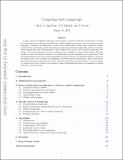Files in this item
Computing finite semigroups
Item metadata
| dc.contributor.author | East, James | |
| dc.contributor.author | Egri-Nagy, Attila | |
| dc.contributor.author | Mitchell, James D. | |
| dc.contributor.author | Péresse, Yann | |
| dc.date.accessioned | 2016-07-15T11:30:13Z | |
| dc.date.available | 2016-07-15T11:30:13Z | |
| dc.date.issued | 2019-05 | |
| dc.identifier | 242971941 | |
| dc.identifier | cb72fe00-16dd-4e2a-ac30-23fa794ca246 | |
| dc.identifier | 85041895021 | |
| dc.identifier.citation | East , J , Egri-Nagy , A , Mitchell , J D & Péresse , Y 2019 , ' Computing finite semigroups ' , Journal of Symbolic Computation , vol. 92 , pp. 110-155 . https://doi.org/10.1016/j.jsc.2018.01.002 | en |
| dc.identifier.issn | 0747-7171 | |
| dc.identifier.other | ArXiv: http://arxiv.org/abs/1510.01868v1 | |
| dc.identifier.other | ORCID: /0000-0002-5489-1617/work/73700798 | |
| dc.identifier.uri | https://hdl.handle.net/10023/9138 | |
| dc.description.abstract | Using a variant of Schreier's Theorem, and the theory of Green's relations, we show how to reduce the computation of an arbitrary subsemigroup of a finite regular semigroup to that of certain associated subgroups. Examples of semigroups to which these results apply include many important classes: transformation semigroups, partial permutation semigroups and inverse semigroups, partition monoids, matrix semigroups, and subsemigroups of finite regular Rees matrix and 0-matrix semigroups over groups. For any subsemigroup of such a semigroup, it is possible to, among other things, efficiently compute its size and Green's relations, test membership, factorize elements over the generators, find the semigroup generated by the given subsemigroup and any collection of additional elements, calculate the partial order of the D-classes, test regularity, and determine the idempotents. This is achieved by representing the given subsemigroup without exhaustively enumerating its elements. It is also possible to compute the Green's classes of an element of such a subsemigroup without determining the global structure of the semigroup. | |
| dc.format.extent | 46 | |
| dc.format.extent | 761068 | |
| dc.format.extent | 770519 | |
| dc.language.iso | eng | |
| dc.relation.ispartof | Journal of Symbolic Computation | en |
| dc.subject | Semigroups | en |
| dc.subject | Monoids | en |
| dc.subject | Regular semigroups | en |
| dc.subject | Subsemigroups | en |
| dc.subject | Algorithms | en |
| dc.subject | Graphs | en |
| dc.subject | Digraphs | en |
| dc.subject | Green's relations | en |
| dc.subject | QA Mathematics | en |
| dc.subject | Algebra and Number Theory | en |
| dc.subject | Computational Mathematics | en |
| dc.subject | DAS | en |
| dc.subject | BDC | en |
| dc.subject.lcc | QA | en |
| dc.title | Computing finite semigroups | en |
| dc.type | Journal article | en |
| dc.contributor.institution | University of St Andrews. Pure Mathematics | en |
| dc.contributor.institution | University of St Andrews. Centre for Interdisciplinary Research in Computational Algebra | en |
| dc.identifier.doi | 10.1016/j.jsc.2018.01.002 | |
| dc.description.status | Peer reviewed | en |
| dc.date.embargoedUntil | 2019-08-14 | |
| dc.identifier.url | http://arxiv.org/abs/1510.01868v1 | en |
| dc.identifier.url | http://arxiv.org/abs/1510.01868v3 | en |
This item appears in the following Collection(s)
Items in the St Andrews Research Repository are protected by copyright, with all rights reserved, unless otherwise indicated.


